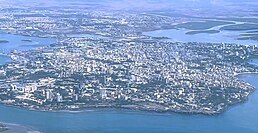
Back Mombasa AF مومباسا Arabic مومباسا ARZ Mombasa AST Mombasa AZ مومباسا AZB Мамбаса BE Мамбаса BE-X-OLD Момбаса Bulgarian মোম্বাসা Bengali/Bangla
Mombasa | |
|---|---|
City and city county | |
Clockwise from top: Mombasa Island, Rooftop restaurant near KPLC offices, a roundabout at Moi Avenue, Sunset in the CBD. | |
Nicknames:
| |
| Coordinates: 4°03′S 39°40′E / 4.050°S 39.667°E | |
| Country | |
| County | Mombasa County |
| Founded | 900 A.D. |
| Government | |
| • Type | County Government |
| • Body | County Assembly |
| • Governor | Abdulsamad Shariff Nassir |
| Area | |
• City and city county | 582,646 km2 (224,961 sq mi) |
| • Land | 219.9 km2 (84.9 sq mi) |
| Elevation | 50 m (160 ft) |
| Population (2019)[1] | |
| • Density | 5,495/km2 (14,230/sq mi) |
| • Urban | 1,208,333 |
| 56,868,723 | |
| GDP (PPP) | |
| • Total | |
| • Per Capita | |
| GDP (NOMINAL) | |
| • Total | |
| • Per Capita | |
| Time zone | UTC+3 (EAT) |
| Area code | 020 |
| Website | mombasa.go.ke |
Mombasa (/mɒmˈbæsə/ mom-BASS-ə; also US: /-ˈbɑːsə/ -BAH-sə) is a coastal city in southeastern Kenya along the Indian Ocean. It was the first capital of British East Africa, before Nairobi was elevated to capital status in 1907. It now serves as the capital of Mombasa County. The town is known as "the white and blue city" in Kenya.[citation needed] It is the country's oldest (c. 900 A.D.) and second-largest city[3] after Nairobi, with a population of about 1,208,333 people according to the 2019 census.[1]
Mombasa's location on the Indian Ocean made it a historical trading centre,[4] and it has been controlled by many countries because of its strategic location. Kenyan school history books place the founding of Mombasa as 900 A.D.[5] It must have been already a prosperous trading town in the 12th century, as the Arab geographer al-Idrisi mentions it in 1151. It was a part of the Kilwa Sultanate from approximately the early 14th century until the dissolution of the sultanate in 1513 A.D. The oldest stone mosque in Mombasa, Mnara, was built c. 1300. The Mandhry Mosque, built in 1570, has a minaret that contains a regionally specific ogee arch. The city later came under the occupation and control of the Omani Empire in the late 17th century.
In the late pre-colonial period, it was the metropolis of a plantation society, which became dependent on slave labour based around the ivory trade. Throughout the early modern period, Mombasa was a key node in the complex and far reaching Indian Ocean trading networks. Its key exports then were ivory, millet, sesamum and coconuts.
Today, Mombasa is a tourism-based town, home to one of the state houses, with an extra-large port and an international airport.
- ^ a b 2019 Kenya Population and Housing Census Volume I: Population by County and Sub-County. Archived 13 November 2019 at the Wayback Machine; retrieved 7 November 2019.
- ^ "GCP". Retrieved 31 August 2021.
- ^ The World Factbook. Archived 7 February 2012 at the Wayback Machine. Cia.gov. Retrieved on 17 August 2013.
- ^ History of Mombasa | Mombasa, Kenya. Archived 21 February 2018 at the Wayback Machine. Mombasainfo.com. Retrieved on 17 August 2013.
- ^ Cite error: The named reference
:2was invoked but never defined (see the help page).






